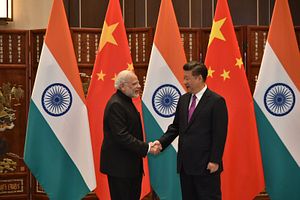As 2017 drew to a close, Beijing made two surprising proposals to further the Belt and Road Initiative (BRI): one, extending the China-Pakistan Economic Cooperation (CPEC) to Afghanistan; and two, linking Pakistan’s Gwadar and Iran’s Chabahar Ports.
These propositions assume significance because as BRI continues to hog the global limelight, India has been quietly promoting its own North-South Transport Corridor (NSTC). These infrastructure plans not only intensify Sino-Indo competition — even potentially working at cross-purposes — but also risk duplicating partnership opportunities for several countries, including those in the Gulf interested in contributing to the projects.
Beijing’s announcement of the BRI (originally known as the One Belt and One Road initiative) in 2013 sought to reinvent the age-old “Silk Road.” The plan is to link China with the economies of Southeast and Central Asia by land and those of the Middle East and Europe by sea.
After being in cold storage since its announcement in 2000, the NSTC made progress with two dry runs in 2014. The project envisions a network of ship, rail and road routes between India and Europe, via the Middle East, Central Asia and Russia. Linking the Indian Ocean and Gulf with the Caspian Sea, the project would make the current routes shorter by almost half and reduce costs by about 30 percent.
Both initiatives are, no doubt, designed to energize Chinese and Indian domestic markets and improve both powers’ international standing. In time, they may also promote infrastructure, business ventures and economies of all the countries falling in and around the projects’ paths.
While the end destination — Europe — is also common to both projects, from a Gulf perspective, the involvement of Oman and Iran in the initiatives is another shared denominator.
With multiple funding deals spanning water, energy and transport sectors, China is keen to use the BRI to multiply the current $31 billion bilateral trade with Iran by 20in the next 10 years.
On the other hand, the commissioning of the first phase of the Chabahar Port in Iran — which is funded partly by India — in late 2017 is a sign of recent progress associated with the NSTC. In fact, India sent its first consignment of wheat to Afghanistan through Chabahar in October last year.
New Delhi is also investing heavily in rail-road developments linking various parts of Afghanistan with Chabahar. The port will then formally be linked to the NSTC, which currently connects Bandar Abbas to Russia, Eurasia and Europe.
At present, BRI dwarfs NSTC in scope and scale. While the BRI has attracted the interest of about 60 countries, the NSTC currently involves only about 15 countries.
More importantly, while the BRI encourages bilateral trade agreements between China and individual countries, the NSTC strengthens multilateral partnerships. Many countries that lack the financial capability to bankroll the development process are nonetheless able to engage with the initiative, encouraging more widespread participation.
Geopolitical Grey Areas
Amid these similarities, differences and opportunities, lie a few grey areas, particularly concerning geopolitical issues and scope for cooperation.
As Afghanistan is already a member of NSTC, China’s bid to include Afghanistan in the BRI, via CPEC, could fuel competition with India, especially since it also involves Pakistan. Adding to the complexity is Pak-Afghan friction. Despite the emphasis on economic development, the Chinese bid to get Afghanistan on board the CPEC may buffer the BRI against possible Taliban sabotage efforts.
India has, thus far, spurned the BRI and has protested the CPEC project because it runs through Pakistan-administered Kashmir, which New Delhi claims is integral to India. China, however, rejects this view, stressing that the project has nothing to do with territorial disputes.
Further, India aided Chabahar Port faces competition from the not-too-distant China-aided Gwadar Port in Pakistan. While Beijing’s call to link the two ports is economically wise, it is politically loaded.
A unique development, however, is the limited scope for the United States in both projects. While Washington might decline to be part of the BRI because of China—an imminent challenger to U.S. global predominance—it would be just as disinclined to be part of the NSTC because of Russia’s stake.
Yet, Iran’s stake in both ventures is likely to get the U.S. interested. While sanctions on the Islamic Republic have stalled progress in the past, the possibility of new sanctions by the Trump administration could pose fresh challenges to both initiatives, thus pitting the U.S. against China and potentially throwing a spanner in Gulf countries’ interests in the projects.
As a result, here are two points for consideration.
One, China and India could devise ways to make their respective ventures less competitive geopolitically and more cooperative geo-economically, both for their own benefit and for the welfare of the other countries involved.
One possible way of achieving this could be to de-emphasize India-China ties from New Delhi’s proximity with Washington and Beijing’s support for Islamabad. This could help the two countries with “oversized egos” to progress from “INCH (India and China) towards MILES (Millennium of Exceptional Synergy).”
Such an understanding could then facilitate India’s participation in the BRI and China’s cooperation in the NSTC.
Two, while the Gulf countries could take the easy option of separately getting on board with both initiatives, wherever possible and beneficial, it may also be worth promoting the idea of connecting the two Asian projects either in the region or beyond.
Since animosity with Iran is likely to be the biggest obstacle for Gulf countries’ participation in either regional initiative, Afghanistan or Central Asia could become potential venues for multilateral cooperation among the concerned countries.
Such a joint pooling of opportunities and resources would make it a win-win proposition for all.
Dr. N. Janardhan is Senior Research Fellow, Gulf-Asia Programme, Emirates Diplomatic Academy and Honorary Fellow, University of Exeter. This article has previously been published on the EastWest Institute Policy Innovation Blog.

































